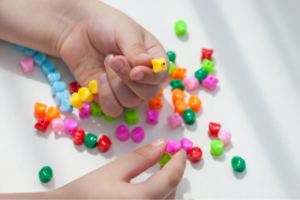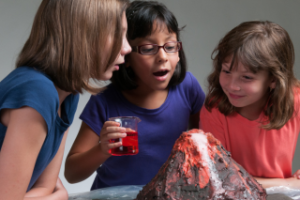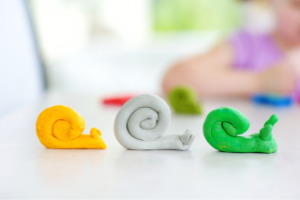Summer holidays are an exciting time for kids, but it can be challenging for parents to keep them entertained indoors. Whether it’s due to hot weather or other constraints, having a list of fun and engaging indoor activities can save the day. In this blog post, we’ve compiled a diverse range of 27 indoor activities to keep your child busy and entertained throughout the summer break. From creative projects to educational games, there’s something for every child’s interest and age group.
Art and Crafts
1. Create a scrapbook or photo album
Creating a scrapbook or photo album is a wonderful way for your child to preserve and cherish their summer memories. Start by gathering photographs, ticket stubs, postcards, and any other mementos from their summer adventures. Encourage your child to arrange these items in a creative and visually appealing way on scrapbook pages. They can use colorful papers, stickers, and markers to add personal touches and write captions or descriptions.
To make it more interactive, children can also include handwritten stories or anecdotes about each photo, capturing the emotions and experiences associated with those moments. Encourage them to get creative with layouts, experimenting with different arrangements and designs. The scrapbook can be themed around specific trips, activities, or simply a collection of favorite summer memories.
2. Paint or draw a masterpiece
Unleash your child’s artistic talents by providing them with paints, brushes, and a canvas or drawing paper. Encourage them to explore their imagination and express themselves through colors and shapes. They can create anything they desire, from landscapes and still life to abstract art or even portraits of family members or pets.
To make it more exciting, you can introduce different painting techniques like splatter painting, using different tools as brushes, or experimenting with textures. Encourage children to try different mediums such as watercolors, acrylics, or pastels. Display their artwork proudly around the house or consider organizing a mini art exhibition where family members can appreciate their masterpieces.
3. Make DIY jewelry or accessories
Encourage your child’s creativity and fashion sense by engaging in DIY jewelry or accessory making. Gather materials like beads, strings, ribbons, charms, and even recycled items like bottle caps or buttons. Provide them with the necessary tools like pliers, glue, and scissors.

Guide them in creating unique bracelets, necklaces, anklets, or even keychains. They can experiment with different colors, patterns, and textures to create pieces that reflect their personal style. This activity not only enhances their fine motor skills but also allows children to showcase their creations as fashionable accessories or thoughtful gifts for friends and family.
4. Design and decorate a T-shirt
Let your child unleash their inner fashion designer by designing and decorating their own T-shirt. Provide them with a plain white or colored T-shirt, fabric markers, fabric paints, or even iron-on patches. Encourage them to brainstorm ideas, whether it’s a favorite quote, a unique pattern, or a vibrant illustration.
 Children can sketch their design directly onto the fabric or use stencils to create precise shapes. Once the design is complete, they can fill it in with colors or add additional embellishments like glitter or sequins. This activity allows children to express their individuality and wear their creations with pride. Plus, it’s a great way to upcycle old or plain T-shirts and give them a new life with a touch of personalization.
Children can sketch their design directly onto the fabric or use stencils to create precise shapes. Once the design is complete, they can fill it in with colors or add additional embellishments like glitter or sequins. This activity allows children to express their individuality and wear their creations with pride. Plus, it’s a great way to upcycle old or plain T-shirts and give them a new life with a touch of personalization.
Remember, the goal is not just the end product but also the process of exploration, creativity, and self-expression. Encourage your child to have fun, take risks, and embrace their unique artistic abilities.
Cooking and Baking
5. Prepare homemade popsicles or ice cream
Beat the summer heat by making delicious homemade popsicles or ice cream with your child. For popsicles, blend fresh fruits like berries, mangoes, or watermelon with yogurt or fruit juice. Pour the mixture into popsicle molds and insert sticks. Freeze them for a few hours until they are set. You can also add fun elements like chopped fruit chunks or a sprinkle of granola for added texture.
For homemade ice cream, you can use an ice cream maker or try the simpler method of combining heavy cream, sweetened condensed milk, and your choice of flavorings like vanilla extract, chocolate chips, or crushed cookies. Mix the ingredients together, pour the mixture into a container, and freeze it until it reaches the desired consistency. Your child can get creative by adding their favorite mix-ins or toppings.
6. Decorate cookies or cupcakes
Unleash your child’s artistic side by decorating cookies or cupcakes. Bake a batch of cookies or cupcakes together using your favorite recipe or a pre-made mix. Once they are cooled, prepare various colors of icing and different types of sprinkles, edible glitter, or small candies.
 Provide your child with tools like icing bags or ziplock bags with the corner cut off, and let them have fun piping and spreading the icing on the treats. Encourage them to experiment with different techniques, such as creating swirls, dots, or even writing messages. They can then embellish the treats with the various decorations, creating their own edible masterpieces.
Provide your child with tools like icing bags or ziplock bags with the corner cut off, and let them have fun piping and spreading the icing on the treats. Encourage them to experiment with different techniques, such as creating swirls, dots, or even writing messages. They can then embellish the treats with the various decorations, creating their own edible masterpieces.
7. Have a themed cooking challenge
Turn your kitchen into a fun cooking competition by having a themed cooking challenge with your child. Choose a theme like “pizza night,” “breakfast bonanza,” or “international cuisine.” Together, decide on the dishes you’ll prepare within the theme.
 Let your child be your Sous Chef. Divide the tasks between you and your child, allowing them to take the lead on certain steps. Encourage creativity and problem-solving as you work together to create a delicious meal. You can set a timer and make it a friendly competition to see who can complete their dish first or who can present the most visually appealing plate.
Let your child be your Sous Chef. Divide the tasks between you and your child, allowing them to take the lead on certain steps. Encourage creativity and problem-solving as you work together to create a delicious meal. You can set a timer and make it a friendly competition to see who can complete their dish first or who can present the most visually appealing plate.
8. Make homemade pizza or sandwiches
Engage your child in the culinary arts by making homemade pizzas or sandwiches. For pizza, start with store-bought pizza dough or make your own. Roll out the dough and let your child choose their favorite toppings, such as cheese, tomato sauce, vegetables, or meats. Allow them to assemble their own personal pizzas, and then bake them in the oven until the crust is golden and the cheese is melted.
 If sandwiches are more to your child’s liking, provide a variety of bread, spreads, meats, cheeses, and vegetables. Let them experiment with different combinations and create their own signature sandwiches. You can even set up a sandwich bar with various fillings and condiments, encouraging your child to try new flavors and textures.
If sandwiches are more to your child’s liking, provide a variety of bread, spreads, meats, cheeses, and vegetables. Let them experiment with different combinations and create their own signature sandwiches. You can even set up a sandwich bar with various fillings and condiments, encouraging your child to try new flavors and textures.
These activities not only keep your child busy but also provide valuable opportunities for learning, creativity, and quality time together. Enjoy the delicious results of your culinary adventures and savor the memories created in the kitchen.
Indoor Games
9. Set up a treasure hunt with clues
Create a thrilling adventure for your child by setting up a treasure hunt with clues. Start by deciding on a theme for the treasure hunt, such as pirates, superheroes, or a favorite storybook. Hide small treats or surprises around the house, and create a series of clues that lead your child from one hiding spot to the next.
Write or print out the clues and strategically place them throughout the house, making sure they are age-appropriate and understandable for your child. The first clue can be given directly to your child, leading them to the first hiding spot, where they will find the next clue. Continue the trail until they finally reach the treasure.
Make the treasure at the end of the hunt exciting and rewarding. It can be a small toy, a special treat, or even a homemade certificate. The anticipation and excitement of solving each clue and finding the treasure will keep your child engaged and entertained.
10. Have a board game tournament
Gather your family and friends for a thrilling board game tournament. Select a variety of board games suitable for different age groups and interests. Encourage friendly competition and let your child take turns choosing the games to play.
Create a tournament bracket or scorecard to keep track of everyone’s progress. Assign points or prizes for winners of each game and tally them up at the end to determine the ultimate board game champion. Make it even more exciting by awarding special titles or trophies to the winners.
Board games not only provide entertainment but also promote critical thinking, strategic planning, and social interaction. They are an excellent way to bond with your child and create lasting memories.
11. Create an indoor obstacle course
Transform your living room into an exciting indoor obstacle course. Use pillows, cushions, and furniture to create obstacles such as tunnels, balance beams, and hurdles. Set up challenges that require your child to crawl under tables, jump over cushions, and maneuver through the course.
Encourage your child to complete the obstacle course as quickly as possible, or challenge them to beat their own time. You can even time each other and make it a friendly competition.
To make it more engaging, add themed elements to the obstacle course. For example, pretend the course is a jungle adventure or a superhero training camp. Use your imagination and involve your child in the process of designing the course.
12. Play charades or Pictionary
Get the whole family involved in a lively game of charades or Pictionary. Charades is a game where players act out words or phrases without speaking, while Pictionary involves drawing clues for others to guess.
For charades, write down a variety of age-appropriate words or phrases on separate pieces of paper. Players take turns drawing a word and acting it out while the others guess what it is. Keep score or play for fun.
In Pictionary, prepare a set of drawing cards with different words or phrases. Divide into teams and take turns drawing clues while the teammates try to guess within a time limit. The team that guesses correctly earns a point.
These games encourage creativity, imagination, and teamwork. They are a great way to enhance communication skills and bring lots of laughter and fun to your indoor activities.
Recommended reading: Screen Time Rules for Kids for Summer Holidays: An Age-by-age Guide
Science Experiments
13. Conduct a volcano eruption experiment
Embark on a thrilling scientific adventure by conducting a volcano eruption experiment. To begin, gather the materials needed: a small plastic bottle, baking soda, vinegar, red food coloring, dish soap, and a tray or container to contain any overflow.
 Create the volcano structure by molding clay or paper mache around the plastic bottle, forming a cone shape resembling a volcano. Place the volcano structure on the tray or container to catch the eruption.
Create the volcano structure by molding clay or paper mache around the plastic bottle, forming a cone shape resembling a volcano. Place the volcano structure on the tray or container to catch the eruption.
Next, mix some vinegar with a few drops of red food coloring and a small amount of dish soap. Pour this mixture into the plastic bottle, filling it about halfway. In a separate container, combine a spoonful of baking soda with a little water to create a paste-like consistency.
Now, it’s time for the eruption! Carefully pour the baking soda mixture into the plastic bottle containing the vinegar mixture. Watch in awe as the chemical reaction between the baking soda (a base) and vinegar (an acid) causes an exciting eruption, complete with bubbling lava flowing down the volcano.
This experiment not only provides a visual spectacle but also teaches children about the principles of chemical reactions and volcanic activity. Encourage them to observe and discuss what is happening during the eruption.
16. Grow plants or herbs from seeds
Engage your child in the wonders of nature by growing plants or herbs from seeds. Choose a variety of seeds that are suitable for indoor growing, such as herbs like basil, mint, or flowers like marigolds or sunflowers.
 Start by filling small pots or containers with potting soil. Place a few seeds in each pot and cover them lightly with soil. Water the pots gently and place them in a sunny spot, ensuring they receive adequate sunlight.
Start by filling small pots or containers with potting soil. Place a few seeds in each pot and cover them lightly with soil. Water the pots gently and place them in a sunny spot, ensuring they receive adequate sunlight.
Teach your child about the importance of watering the plants regularly and caring for them as they grow. Encourage them to observe the changes in the plants over time, from seedlings sprouting to full-grown plants.
Take this opportunity to educate your child about the life cycle of plants, the importance of sunlight and water, and the joy of nurturing living things. As the plants grow, your child will feel a sense of accomplishment and connection with nature.
15. Make slime or playdough
Unleash your child’s creativity with the exciting activity of making slime or playdough. Slime is a gooey, stretchy substance that children love to play with, while playdough provides a malleable material for shaping and sculpting.
 To make slime, you’ll need a few basic ingredients such as glue, liquid starch or borax, and food coloring. Mix the glue with the desired color and slowly add the liquid starch or borax until the slime reaches the desired consistency. Knead and play with the slime to experience its unique texture.
To make slime, you’ll need a few basic ingredients such as glue, liquid starch or borax, and food coloring. Mix the glue with the desired color and slowly add the liquid starch or borax until the slime reaches the desired consistency. Knead and play with the slime to experience its unique texture.
For playdough, combine flour, salt, water, oil, and food coloring to create a soft, pliable dough. Adjust the ingredients as needed to achieve the desired texture and color. Let your child’s imagination run wild as they shape and mold the playdough into various creations.
Both slime and playdough provide sensory experiences that promote fine motor skills, creativity, and imaginative play. They can be stored in airtight containers for future playtime enjoyment.
16. Explore the density of liquids
Introduce your child to the fascinating concept of density by conducting experiments with different liquids. Gather a variety of liquids with different densities, such as water, oil, honey, and syrup. You can also add food coloring to distinguish between the liquids more easily.
Fill several clear containers with each liquid, leaving enough space for additional liquids to be poured. Start with the densest liquid and gradually add the less dense liquids, one by one, into the containers. Observe how the liquids stack on top of each other, with the denser liquids sinking to the bottom.
Encourage your child to predict and discuss which liquids they think will be denser or less dense than others. You can even experiment with adding objects of different densities, such as coins or small toys, to see how they interact with the liquids.
This activity provides a hands-on experience for children to understand the concept of density and how different liquids can behave differently based on their density. It sparks curiosity and critical thinking skills as they make observations and draw conclusions about the behavior of liquids.
Reading and Writing
17. Start a summer reading challenge
Encourage your child to embark on a summer reading challenge that will ignite their imagination and foster a love for books. Set a goal together, such as reading a certain number of books or exploring different genres throughout the summer.
 Create a reading log or chart to track their progress. Let them choose books that align with their interests, whether it’s adventure, fantasy, mystery, or non-fiction. Visit the local library or explore online resources to find a diverse range of books suitable for their age and reading level. Make reading a fun and interactive experience by setting aside dedicated reading time each day. Create cozy reading nooks with comfortable pillows and blankets, and let them explore different settings like reading outdoors or building a fort with books.
Create a reading log or chart to track their progress. Let them choose books that align with their interests, whether it’s adventure, fantasy, mystery, or non-fiction. Visit the local library or explore online resources to find a diverse range of books suitable for their age and reading level. Make reading a fun and interactive experience by setting aside dedicated reading time each day. Create cozy reading nooks with comfortable pillows and blankets, and let them explore different settings like reading outdoors or building a fort with books.
Discuss the books they read together, asking questions about their favorite characters, plot twists, or lessons learned. Encourage them to share their thoughts and opinions through drawings, book reviews, or discussions.
18. Write and illustrate a storybook
Spark your child’s imagination by encouraging them to write and illustrate their own storybook. Provide them with blank sheets of paper or a notebook where they can create their unique tales. Encourage them to brainstorm ideas for characters, plotlines, and settings.
Guide your child through the process of writing their story, helping them develop a beginning, middle, and end. Encourage descriptive language and creative storytelling techniques. Once the story is written, they can bring it to life by illustrating the pages with colorful drawings or using collage techniques.
By creating their storybook, children enhance their writing skills, storytelling abilities, and artistic expression. It also boosts their confidence and pride in their creative accomplishments.
19. Create a journal or diary
Introduce your child to the joy of journaling by helping them create their own journal or diary. Provide them with a notebook or journal and encourage them to write about their thoughts, feelings, and experiences.
Set aside a dedicated time each day or week for journaling. Encourage your child to write about their daily activities, special moments, dreams, or aspirations. They can also include drawings, photographs, or mementos that capture their memories.
Journaling allows children to express themselves, reflect on their emotions, and improve their writing skills. It serves as a personal keepsake of their journey through the summer holidays and helps them develop self-awareness and mindfulness.
20. Research and write about a favorite topic
Encourage your child’s curiosity and love for learning by inviting them to research and write about a topic they are passionate about. Help them select a subject that interests them, such as animals, space, sports, or any other area they want to explore.
Provide access to age-appropriate books, websites, and resources related to their chosen topic. Encourage them to take notes, gather information, and organize their findings. Assist them in structuring their research into a coherent piece of writing, such as an informative essay or a short report.
This activity fosters critical thinking, research skills, and the ability to communicate information effectively. It allows children to delve deeper into a subject they are enthusiastic about, becoming mini-experts in their chosen field. Celebrate their efforts by sharing their work with family and friends or creating a mini-presentation to showcase their newfound knowledge.
Indoor Camping
21. Set up a blanket fort or tent
Transform your living room or any suitable indoor space into a magical hideaway by creating a cozy blanket fort or tent. Gather blankets, sheets, and pillows to construct the structure. Use chairs, tables, or other furniture as support for draping the blankets and creating walls.
 Encourage your child to get creative with the design, arranging the blankets in a way that creates multiple rooms or secret passages. Add fairy lights or string lights for a whimsical touch. Fill the fort with comfortable pillows and blankets for a cozy atmosphere.
Encourage your child to get creative with the design, arranging the blankets in a way that creates multiple rooms or secret passages. Add fairy lights or string lights for a whimsical touch. Fill the fort with comfortable pillows and blankets for a cozy atmosphere.
This imaginative space provides a cozy retreat where your child can read books, play board games, or even have a picnic. It encourages imaginative play, sparks creativity, and creates a sense of adventure in the comfort of your own home.
22. Have a pretend campfire and tell stories
Bring the camping experience indoors by creating a pretend campfire. Arrange cushions or stools in a circle to represent the campfire seating. Use yellow or orange tissue paper, fabric, or construction paper to create flames that can be placed in the center.
Gather your family around the campfire and take turns telling stories. Encourage your child to share their own imaginative tales or ask them to come up with stories based on a theme. Use props like flashlights or lanterns to set the ambiance and make it feel more realistic.
Storytelling not only stimulates creativity but also improves language skills and promotes family bonding. It allows your child to express their ideas and develop their storytelling abilities in a fun and interactive way.
23. Sleep under the “stars” with glow-in-the-dark stickers
Create a celestial experience for your child by turning their bedroom ceiling into a starry night sky using glow-in-the-dark stickers. Purchase adhesive glow-in-the-dark stars, planets, and other celestial shapes available at craft stores or online.
Before bedtime, help your child apply the stickers to the ceiling in a random pattern, mimicking the night sky. Ensure the room is completely dark and allow the stickers to absorb light during the day. Once the lights are turned off, the stickers will emit a soft glow, creating a mesmerizing starry ambiance.
Sleeping under the “stars” can be a magical experience for your child. It encourages their imagination, creates a soothing environment for sleep, and sparks their interest in astronomy and the wonders of the universe.
Virtual Field Trips
24. Take a virtual tour of famous museums or landmarks
Explore the world of art, history, and culture from the comfort of your home by taking virtual tours of famous museums and landmarks. Many renowned institutions offer online tours that allow you to navigate through galleries and exhibitions.
Start by researching museums or landmarks that offer virtual tours. Websites and apps like Google Arts & Culture provide access to a wide range of virtual tours and collections. Select a destination that interests your child and embark on a digital exploration.
As you navigate through the virtual tour, encourage your child to engage with the exhibits by reading descriptions, viewing artworks or artifacts, and learning interesting facts. Discuss the significance of the pieces and encourage your child to ask questions and share their thoughts.
Virtual museum tours provide an immersive and educational experience, allowing your child to discover the world’s treasures and broaden their knowledge of different cultures and historical events.
25. Explore different ecosystems through online resources
Take your child on a virtual journey to explore diverse ecosystems around the world. Use online resources, such as videos, documentaries, and interactive websites, to introduce them to various habitats like rainforests, deserts, coral reefs, and more.
Start by selecting an ecosystem to focus on. Find age-appropriate videos or documentaries that showcase the unique characteristics, flora, and fauna of that ecosystem. Encourage your child to observe and learn about the animals, plants, and environmental conditions that make each ecosystem special.
To make the experience more interactive, use online resources that offer virtual field trips or 360-degree tours of specific locations. These immersive experiences allow your child to explore different ecosystems virtually and gain a deeper understanding of their complexity.
As your child explores different ecosystems, prompt them to think critically about the importance of biodiversity, conservation efforts, and the impact of human activities on these fragile environments. Encourage discussions about sustainability and ways they can contribute to the protection of ecosystems.
26. Visit a zoo or aquarium virtually
Bring the wonders of wildlife into your home by embarking on a virtual visit to a zoo or aquarium. Many zoos and aquariums offer live webcams and virtual tours that allow you to observe animals in their habitats and learn about their behaviors.
Research zoos and aquariums that provide virtual experiences. Visit their websites or social media platforms to find live webcams or pre-recorded videos of animals. Choose different exhibits or specific animals that interest your child and embark on a virtual adventure.
During the virtual visit, encourage your child to observe the animals closely, learn about their characteristics and habitats, and even take notes or sketch their favorite animals. Discuss interesting facts and engage in conversations about animal conservation and the importance of protecting their natural habitats.
Virtual zoo and aquarium visits provide a unique opportunity for your child to develop empathy for animals, gain knowledge about different species, and foster a love for wildlife.
27. Learn about space with virtual planetarium tours
Ignite your child’s curiosity about the universe by taking virtual planetarium tours. Planetariums offer immersive and educational experiences that allow you to explore the wonders of space, celestial bodies, and astronomical phenomena.
Start by researching planetariums that offer virtual tours or shows. Many institutions provide online platforms where you can access interactive presentations and visualizations of the cosmos. Select a virtual tour or show that suits your child’s age and interests.
As you embark on the virtual journey through space, discuss various celestial objects like planets, stars, galaxies, and comets. Encourage your child to ask questions and prompt their imagination by discussing possibilities like extraterrestrial life or space exploration.
To enhance the experience, consider using stargazing apps or websites that provide real-time views of the night sky from different locations. This allows you and your child to identify constellations, track the movement of planets, and deepen your understanding of the night sky.
Virtual planetarium tours offer a fascinating glimpse into the vastness of the universe and help your child develop an appreciation for astronomy and scientific exploration.
With these 50 indoor activities, you have a wide range of options to keep your child engaged, entertained, and learning during the summer holidays. Remember to choose activities that align with their interests and age group. Don’t be afraid to mix and match different activities to keep things exciting. By providing a variety of experiences, you’ll help your child develop their creativity, problem-solving skills, and knowledge. Have a fantastic summer filled with fun and memorable indoor adventures!




